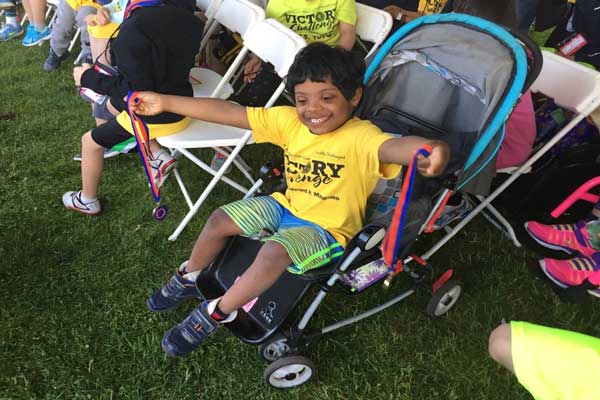I stared at her in utter shock trying to make sense of what I’d just heard her say. The words reverberated in my head like some distant thumping, bringing a lump to my throat that I couldn’t swallow. Was this really happening to me! I felt her soft touch on my shoulder as she gently reiterated for the third time, “It is a difficult decision, you don’t have to decide now. Think about it and I’m available to answer your questions.” I looked up at her in disbelief. How could a doctor be suggesting such a thing when my life was not in any danger? I took a deep breath and sighed as Dr. Anette gently rubbed my shoulder, and then I looked at her and crisply replied, “I’m keeping my baby no matter what.” “Think about it,” she went on, “it’s not that simple. There are a lot of challenges…heart defects, hearing problems, digestion issues, childhood cancer, early onset of Alzheimer’s….and she went on and on, not once mentioning that my baby would still just be a baby, a child who loves and cries, who wants to snuggle and play, who is oblivious to his or her challenging diagnosis and just wants to be loved!
Her voice faded away as I made my way out of her office, walking in a trance. “So, what did the doctor say?” I heard my husband ask excitedly. “Everything okay?” I took a deep breath, looked into his eager eyes, held his hands and gently whispered, “I am a high-risk candidate for carrying a baby with Down Syndrome. The doctor presented an option.” Confused, my husband repeated what I said. “Presented an option?” I replied, “She said we can terminate the pregnancy and be free of numerous challenges and hardships.” As I spoke, my voice quivered, and the color of my husband’s face changed. Only Allah knows how much we had yearned for this baby, what we had endured to get here and now when we were just months away from holding him in our arms, we were being told that it may be better to abort him! All because he may be born with Down Syndrome.
Over the next few months, every time I walked into Dr. Anette’s office for my regular checkup, I was offered the option, until finally Dr. Anette suggested I should talk to a psychologist about it! I had kept my cool every time she suggested “the option,” politely informing her that we are happy and content with our decision to welcome our baby. But that day, I exploded. “The diagnosis of Down Syndrome is not the worst thing that can happen to an expectant parent,” I vehemently retorted. “Are you a parent?” I asked Dr. Anette, “Don’t people with Down Syndrome deserve a right to live and be included in this life? Aren’t there solutions for all the medical challenges they have? How could terminating life be the only solution and that too, one that relieves the parent of a ‘burden’ — the unborn baby!” I was 24 weeks now and Dr. Anette, ignoring my imploring questions, calmly went on to say that this was the last week that we could undergo the procedure to terminate my baby with Down Syndrome. I rushed out of her office and asked to talk to her supervisor. Upon listening to my sense of frustration that the doctor had over and over asked if I wanted to terminate my pregnancy, “terminate” my baby, he professionally informed me that she was doing her job and it was her duty to inform me about the option to terminate my pregnancy after finding out that my baby would be born with Down Syndrome! That was the moment I realized that not only would I have to deal with medical challenges facing my baby, but also immense social and emotional challenges. But I was determined to be his advocate and voice.
Fast forward 10 years and Hamza is the joy of our family. He is the best gift that Allah could have given us. His smiles, hugs, and kisses can cheer the saddest person and his overall presence is energizing. He has his fair share of challenges, which he struggles with. But the best part is he never gives up and perseveres through the most difficult tasks, just at his own pace. He is my teacher in life, and I wouldn’t change one chromosome in him!
Down Syndrome Awareness Month
October is Down Syndrome Awareness Month and a time to celebrate people with Down Syndrome and make others aware of their abilities and accomplishments. Down Syndrome is named after the English doctor John Langdon Down who was the first to categorize the common characteristics of people with the condition. The colors for Down Syndrome awareness are blue and yellow.
Down Syndrome is the most common genetic disorder. While there are three types of Down Syndrome, one type, Trisomy 21, accounts for 95 percent of people with Down Syndrome. In this type, the individual has three copies of chromosome 21 rather than the usual two. There is about 1 in 700 babies with Down Syndrome born each year in the U.S. The chances of having a baby with Down Syndrome are higher in older women.
Some common physical characteristics include almond-shaped eyes slanting upwards, poor muscle tone, short stature, a flat nasal bridge, a protruding tongue, and a single deep crease across the center of the palms. People with Down Syndrome may have some or all of these physical characteristics, as well as a number of others. The presence of part or whole of the extra chromosome also affects a person’s cognitive ability, causing intellectual disability. Yet, studies have shown that children with Down Syndrome learn best alongside their typically developing peers and so need to be included in such settings or least-restrictive learning environments. They have mild to moderate developmental delays and reach milestones later than their typically developing peers. Early Intervention techniques and therapies in the first five years are critical to the optimal development and progress of children with Down Syndrome. Medical issues can vary from mild to severe. Around half of all people with Down Syndrome have congenital heart defects and there may be a higher risk of respiratory problems, hearing issues, thyroid conditions, early onset of Alzheimer’s, and childhood Leukemia. Fortunately, medical advancements have made it possible to address these issues. In the 1960s, the life expectancy of a person with Down Syndrome was 25 years, but with medical advancements, the life expectancy has expanded to 60 years.
Sadly, however, even with all the medical advancements, inclusion with peers in academic settings, and early intervention techniques — all improving the lives of people with Down Syndrome —the number of abortions of Down Syndrome fetuses is increasing around the world. In the U.S., the rate of terminating a Down Syndrome fetus is over 70 percent and in Europe the numbers are even more staggering. Iceland claims to have “cured” Down Syndrome, the “cure” being almost 100 percent termination of Down Syndrome fetuses. The push to eliminate these beautiful souls is on the increase every decade.
Back to Hamza’s Story
The journey of raising a child with Down Syndrome can be daunting and intimidating. The challenges can vary from mild to extreme, but with far better guidance and resources easily accessible now, all of these can be overcome. Hamza is the purest soul I have ever met in my 50 years of life. He is extremely sociable and loves people. His smiles are contagious, and his hugs are healing. He is a willing learner, mostly, and though he struggles hard to achieve basic tasks, he never gives up. His resilience to keep on trying his best to participate and interact is admirable. He is pure joy and the sunshine in one’s darkest hour. He can put a smile on the saddest face with his charming personality. Yet, he has his moments too. He has the full spectrum of human feelings and desires to be loved and included.
Unfortunately, our communities are not fully aware of, and comfortable with, Down Syndrome. Although research verifies that inclusion benefits children with Down Syndrome, schools are still reluctant to implement this. Sadly, many parents of typically developing children fear that their children will regress if they are around children with cognitive and developmental delays. In fact, being with children with Down Syndrome can increase understanding and compassion. Yet, many children with Down Syndrome are rejected and denied their right to participate in various social and athletic programs. It does require additional effort and planning to include children with Down Syndrome in all activities, but that is the way forward. They can learn and participate, just at a different pace.
There are many ways to support greater awareness of Down Syndrome and to participate in, and advocate for, inclusion. You and your child can befriend a child with Down Syndrome and his or her family; you can participate in the annual Buddy Walks (held in about 40 states across the country); you can join and volunteer in groups that provide information and resources such as the National Down Syndrome Society (NDSS), Down Syndrome Advocacy Foundation (DSAF), and Gigi’s Playhouse (across the country). There are numerous books available for children and adults about Down Syndrome. You can follow Facebook and Instagram pages such as Parents of Children with Down Syndrome or Noah’s Dad for valuable and informative resources and latest developments. Hope Story, of which I am a Hope Advocate, is a non-profit group aiming to educate and support parents who have received prenatal diagnosis of Down Syndrome. We are open and happy to talk to the expectant parent(s), offering hope, information, and support as we share our own family’s story of living with and loving a child with Down Syndrome.
In conclusion, as a parent of a child with Down Syndrome, I encourage people to learn more about Down Syndrome and open their minds and hearts to such individuals. They have a beauty all their own and can teach many things about life, adversity, and joy. Without exaggeration, knowing and interacting with a person with Down Syndrome can greatly enrich your life!





